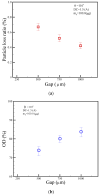Magnetic Beads inside Droplets for Agitation and Splitting Manipulation by Utilizing a Magnetically Actuated Platform
- PMID: 37512660
- PMCID: PMC10384566
- DOI: 10.3390/mi14071349
Magnetic Beads inside Droplets for Agitation and Splitting Manipulation by Utilizing a Magnetically Actuated Platform
Abstract
We successfully developed a platform for the magnetic manipulation of droplets containing magnetic beads and examined the washing behaviors of the droplets, including droplet transportation, magnetic bead agitation inside droplets, and separation from parent droplets. Magnetic field gradients were produced with two layers of 6 × 1 planar coils fabricated by using printed circuit board technology. We performed theoretical analyses to understand the characteristics of the coils and successfully predicted the magnetic field and thermal temperature of a single coil. We then investigated experimentally the agitation and splitting kinetics of the magnetic beads inside droplets and experimentally observed the washing performance in different neck-shaped gaps. The performance of the washing process was evaluated by measuring both the particle loss ratio and the optical density. The findings of this work will be used to design a magnetic-actuated droplet platform, which will separate magnetic beads from their parent droplets and enhance washing performance. We hope that this study will provide digital microfluidics for application in point-of-care testing. The developed microchip will be of great benefit for genetic analysis and infectious disease detection in the future.
Keywords: agitation; digital microfluidics; magnetic manipulation; splitting; washing.
Conflict of interest statement
The authors declare no conflict of interest.
Figures














References
-
- Cho S.K., Moon H., Kim C.J. Creating, transporting, cutting and merging liquid droplets by electrowetting-based actuation for digital microfluidic circuits. J. Microelectromech. Syst. 2003;12:70–80.
-
- Darhuber A.A., Valentino J.P. Thermocapillary actuation of droplets on chemically patterned surfaces by programmable microheater arrays. J. Microelectromech. Syst. 2003;12:873–879. doi: 10.1109/JMEMS.2003.820267. - DOI
-
- Wixforth A. Flat fluidics: Acoustically driven planar microfluidic devices for biological and chemical applications. Transducers. 2005;1:143–146.
LinkOut - more resources
Full Text Sources

